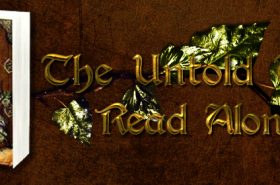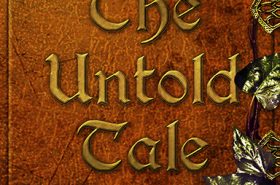I remember, back in the day, (nothing makes you feel old like starting a sentence with “back in the day”) Fantasy and Sci-fi were commonly known by only two genre names– Fantasy and Sci-fi. OK, maybe that’s not 100% accurate. There were probably a few subgenres, but those only really mattered if you were inside the publishing industry. Readers didn’t care about the distinction. Maybe they still don’t. I don’t know. But bookstores do, and the Mighty Zon’s recommendation algorithms definitely do. Classifying your book with the correct genre headers can mean the difference between actually finding readers and getting lost in a sea of other titles like a piece of driftwood. But with a plethora of subgenres to choose from, how is a writer supposed to figure out where their book fits?
Fantasy alone has 31 recognized subcategories. 31! So it’s no surprise that the distinctions between them can begin to blur. I know. I’m guilty of doing it myself. On any given occasion, I’ll declare Unmoving (My current WIP) either Urban Fantasy, Contemporary Fantasy or some combination of the two. Because the truth is, I didn’t really understand the difference. In my mind, they were virtually the same thing.
Further research proved that although Urban and Contemporary are indeed very similar, they also have distinct differences that set them apart. Curious what those distinctions are? I thought you might be. Which is why I’m going to use my newfound knowledge to give you a break down of the more common Fantasy subgenres. That way you can declare your work a Comic/Arthurian/Steampunk masterpiece with confidence. Or, you know, whatever combination of subgenres it happens to be. 😉
Alternate History Fantasy
This type of Fantasy takes real world events and creates an alternate outcome, resulting in a fictitious world that may still resemble ours. For example, Alternate History asks questions like, “What if we had lost World War 1 or 2?” The resulting progression of history from that deviating point would be the goal of the story, allowing the author to play with imaginary elements (including the light use of magic) while keeping the believability of the timeline.
Arthurian Fantasy
Just like the name implies, this includes any story inspired by the King Arthur legends. Whether it’s a literal retelling or simply based within that world, this subgenre is fairly straight-forward. Probably one of the most well-known examples of this is The Mists of Avalon by Marion Zimmer Bradley.
Comic Fantasy
This is the spoof category, where you’ll find over-the-top situations featuring Fantasy elements. Whether humorous or satirical, this subgenre is meant to amuse. Common examples include the Xanth novels by Piers Anthony, Monty Python (I know, not a book) and to some extent, The Princess Bride by William Goldman.
Contemporary/Modern Fantasy
Contemporary Fantasy simply means it’s Fantasy set in modern times. Magic and magical creatures mix with the everyday world we all know. The important thing that distinguishes this from Urban Fantasy is the location. Unlike Urban Fantasy, Contemporary can take place in any setting, as long as the time period is current. It also tends to be lighter in tone than its Urban counterpart.
Cross-Over Fantasy
When I first saw this, I thought it was referring to the blending of Fantasy with other non-Fantasy genres. But actually, it refers to stories where the characters can cross between realms and/or time periods. The only example I can think of that fits would be the Magic Kingdom of Landover series by Terry Brooks.
Dark Fantasy
Ah, my favorite subgenre and the one that most of my work falls into. Dark Fantasy contains elements of Horror, so you’ll see a lot of the darker supernatural creatures appear here. But it also refers to the overall tone of a piece. Dark Fantasy is grittier than it’s more traditional brethren, dealing with the nastier bits of humanity’s psyche. There can be (and often is) a significant amount of violence and gore and it usually contains themes meant to make a reader slightly uncomfortable. So even if there are no vampires, werewolves, demons, etc, a novel can still be classed Dark, simply by it’s voice and subtext.
Dystopian Fantasy
I don’t think is actually considered it’s own subgenre yet, but trust me, it will be soon. Thanks to the likes of Suzanne Collins’ Hunger Games Trilogy, Dystopian Fantasy has rocketed up the popularity charts. Fantasy has long played with utopian ideals, containing societies/races in perfect balance with nature, where peace and love reign. Dystopian is the exact opposite. The apocalypse has happened and humanity is suffering under the thumb of a dictatorial society that believes it’s utopian. Usually containing a lot of Sci-Fi elements as well, this subgenre features a lot of rebellion and “down with the man!” mentalities. But hiding beneath that is a cautionary message of hope that humanity can still manage to avoid such a desolate fate.
Epic/High Fantasy
Otherwise known as your stereotypical idea of Fantasy. This is the bread and butter of the genre and the one I expected to write in when I first started out. (It wasn’t until I was much older that I realized I found the intricacies of personality and psychology far more fascinating than the intricacies of politics and fictitious cultures.) Hallmarks of this subgenre include immense, sprawling worlds with rich histories and more detail than most readers would ever care to know. Expect to see hand-drawn maps and be introduced to intricately crafted cultures, magic and political maneuvering. Think Tolkien’s Lord of the Rings. Enough said, right?
Fairy Tales/Mythology
What would Fantasy be without Fairy Tales and Mythology? Although many of the original Fairy Tales have been watered down for modern sensibilities, the original stories were often violent, dark and twisted, meant to terrify children into learning a lesson. This is a subgenre rich in the history of storytelling, drawing on thousands of years of cultural traditions and is an endless well of inspiration for Fantasy writers. Many of the books currently on the market can be boiled down to the retelling of a Fairy Tale or Myth, including my own WIP, which draws loosely from Sleeping Beauty.
Heroic Fantasy
Where Epic Fantasy focuses on the world and the overarching idea of good vs. evil, Heroic Fantasy focuses on the characters, primarily– you guessed it– the hero. Think of Epic Fantasy as a birds eye view and Heroic Fantasy as the close-up. Often, it will feel very similar to Epic/High Fantasy, with medieval settings, magical creatures, and good vs. evil. But it will stay closer to the hero’s personal journey and growth as a character, and often features a true damsel-in-distress.
Historical Fantasy
Historical Fantasy is the long lost brother of Historical Fiction. It takes an actual time or event from history and blends in Fantasy elements similar to the way Contemporary and Urban Fantasy do. Starting to get confused yet? Yeah, me too.
Low Fantasy
High Fantasy consists of large sweeping worlds, epic battles and a ton of detail, right? So it’s safe to assume that Low Fantasy is the exact opposite. It usually contains little to no magic and more ordinary surroundings. This is a subgenre that is rarely used anymore, since it appears that writers who want this sort of thing tend to aim for the more contemporary variations– Modern or Urban or even Juvenile (strictly for kids). Kind of makes you wonder why it’s still considered a thing if no one uses it, huh?
Literary Fantasy
Literary Fantasy was created for all the snobby writers who didn’t want to be left out of the fun. (Just kidding.) This subgenre focuses on the actual writing rather than the other elements of storytelling. It uses things like format and style to deliver its message, often creating progressive narratives that don’t appeal to the mass market. Just like the Literary genre is aimed at a niche of highly intelligent readers, Literary Fantasy targets readers who like a little imagination in their pretension. 😉
Magic Realism
This refers to the type of magic included in a tale, and as such, is most often seen paired with another subgenre. Magic Realism means that magic is an accepted part of the story’s world and operates under a strict set of rules. There are no unexplained, miraculous saves by magic allowed in this subgenre and using magic is often followed by negative consequences. The need for implements and tools to channel magical abilities is also commonplace here, giving magic a requirement of skill and work rather than mere blessed luck.
New Weird/Slipstream
This is a sister subgenre to Literary in that it actively tries to break the conventions of Fantasy. The landscapes and characters are often bizarre and the language can be highly stylized or poetic.
Paranormal Fantasy
This subgenre has seen a massive boost over the past decade, thanks to the ever-popular variation of Paranormal Romance. By it’s most basic definition, Paranormal means anything not normal. (Well, no S*** Sherlock, you don’t say.) So the same cast of inhuman creatures that show up in Contemporary, Dark and Urban Fantasy show up here. (Man, those vampires and werewolves really get around!) The most common plots seen in this subgenre are the romantic ones, which are often combined with a detective/police element. (Because only sexy cops can see the supernatural apparently.) But you will also see the age old battle of good vs evil and heroes trying to stop the subhuman from taking over the world.
Romantic Fantasy
This subgenre combines Romance with Fantasy in one powerhouse combination. How is that different from Paranormal Romance, you ask? Paranormal Romance is usually dark and gritty, and Romantic Fantasy doesn’t have to be. Romantic Fantasy focuses on the romance itself, relying on the question of “will they or won’t they” to drive the plot, while the love story can simply be an added bonus in Paranormal Romance.
Sword and Sorcery
This is another staple of the Fantasy genre. Back in the early days, (Ack! There it is again! The reminder that I’m old) if you weren’t writing Epic Fantasy, you were considered Sword and Sorcery. This is an action-driven subgenre, with sword-wielding heroes facing off against magic-wielding villains in brutal battles to the death. It’s kind of similar to Heroic Fantasy in that way, where the war between good and evil takes center stage. But where Heroic Fantasy focuses on the character, Sword and Sorcery cares about the badass fight scenes.
Steampunk Fantasy
This is another fairly new subcategory. Pulling from the Steampunk movement, Steampunk Fantasy lives in an alternate universe where combustion was never discovered. Technology is reminiscent of the old west, with steam-powered everything, and the settings are usually Gothic or Victorian with a definite feel of the Industrial Revolution. Plots in this subgenre typically pull from similar themes as Dark and Urban Fantasy, with those promiscuous vampires, werewolves and demons popping up yet again. The important thing about this subgenre is the adherence to the rules of Steampunk.
Urban Fantasy
Last, but not least, we have Urban Fantasy. As mentioned above, during our definition of Contemporary Fantasy, Urban Fantasy is dark by nature. It’s gritty and bloody and showcases the uglier side of humanity. And it absolutely has to take place in a city. Hence the “urban” designation. But, unlike Contemporary/Modern Fantasy, that city can be in any time period. Most often, it will be current times, but it doesn’t have to be. Which is why you’ll also see a lot of the Urban style in Steampunk and Paranormal.
So, there you have it. A cheat sheet to some of the more popular Fantasy subgenres. This is by no means a comprehensive list, so if you feel I’ve overlooked an important one, (or gotten the definitions completely wrong) feel free to add/fix it via the comments below. As you can see, many of these subgenres overlap or can be combined to create new ones, making the task of defining your book all the harder. But hopefully I’ve helped clarify things, at least a little. I know I’m much more confident defining my work now, after learning all of these. Are you?
**This post has been syndicated from Senior Editor Kisa Whipkey’s personal blog, Nightwolf’s Corner.**



